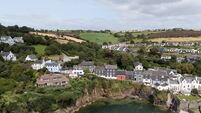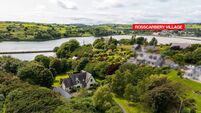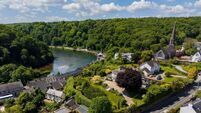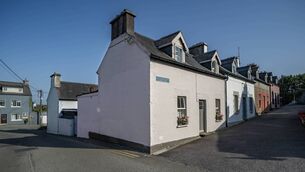Ready for the Clew Bay city rollers
Inishturkbeg, (the small island of the wild boar, is about to get talked about, in some very strange and exclusive quarters of the world. Rock stars and super-models will be among its first paying guests, followed by large corporate companies doing luxury accommodation bonding and brainstorming sessions in the wild, alongside big family gaterhings. You know the way posh hotels and spa retreats pamper you with fluffy robes and soft slippers? Well, Inishturkbeg will cosset people indoors in their slippers, but encourage them outdoors in their Wellingtons… which guests get to keep.
It will lend its name to a whiskey, a range of toiletries, perhaps some seafoods, and a range of clothing, including the aforementioned wellies? Its island shape is being fashioned as a brand, done with wit and style.
The Mayo shoreline and its part-sheltered inlets here is said, in a certain exaggeration, to be home to 365 islands, one for each day in the year… counted no doubt at low tide. But there’s plenty of genuine, enervating islands to go around, one for each of a very wide and individual audience of owners, in fact.
The Clew Bay selection has previously attracted a mix of island devotees: Louis Walsh owns one, and John Lennon bought one of Clew Bay’s islands, Dorinish, back in 1967, and more recently another, Inishraher, was set to become a ‘Maharishi (Mahesh Yogi) Capital of the Global Country of World Peace’!
In 2003, the very grounded London-based, but Irish-rooted and half Irish/half Egyptian Nadim Sadek, with his wife Sandra O’Malley, bought ‘their’ island, Inishturkbeg, which hit some headlines in the early 2000s back when singer Ronan Keating was briefly linked with a move to buy its scenic 63 acres. Sandra has Westport family roots, but probably not as far back as the middle ages, when Grace O’Malley, Granuaile, was the pirate queen of the day, on nearby Clare Island.
Fetching up on bracing Inishturkbeg Island, with its ‘a lungful of life’ slogan as healthily voiced by Nadim Sadek, is possibly ironic, as he had in fact spent a childhood travelling to some of the world’s unhealthiest spots. His Egyptian father, an epidemiologist with the World Health Organisation (WHO), went where need was greatest, and by the time young Nadim was 12, his father and his Limerick-born mother decided to quarantine him more safely in a boarding school in Dublin, St Columba’s in Rathfarnham.
Sadek subsequently studied psychology in TCD, went into business and made – one can safely assume – a small but perfectly-formed fortune when his company, the qualitative research (marketing) firm Sadek Wynberg was taken over in 2003 by WPP, later co-branding with Millward Brown.
That international marketing entity employed thousands of people, worldwide, and business travel around the globe to far-flung offices was a weekly ritual for the 40-something consumer psychologist, who stepped back from that daily titled CEO/Global Leader grind and has now slowed down just a whit to island life pace and a new, self-referential title of ‘Chief Islander’.
Now, the international shift is in another, ‘Small is Beautiful’ direction, to the west of Ireland, Co Mayo, Atlantic coastline, in the beguiling shape and setting of Inishturkbeg. As Nadim says, he was “beguiled by the spirit of the place, I’m passionate about islands, and entranced by my own. The aim was to preserve its nature, and to let other people understand the effect an island can have on their spirit and relationships.”
In 2003, Nadim and Sandra (with adventurous, water-loving children Searsha, Shaefri, Seán and Oisín) began a family odyssey with the initial €1 million-plus purchase (aided by country house sales specialist Michael H Daniels, an old school friend) of most of Inishturkbeg, from an older Dutch couple, and bought up a few more pieces of its land to give full island ownership, all 63 acres of it, some 49 metres at its highest point above sea level. Then, it had a main house at one end, a cottage or town and the ruins of five or six old stone dwellings from previous centuries. It is likely the island supported six families in the 1800s. But, no roads, no water, no power supply.
Fast-forward five years, and zap through a planning process that included, briefly, plans for some underground, burrow-like houses with glass, Tellytubby-like dome entrances – conceived, but not yet delivered.
Instead, the UK/European Young Architects of the Year 2000 Andrew Wright Associates came up with a master plan that now sees five super-stylish houses built to the highest international standard, in the unlikeliest of settings. They range from some small dwellings, of 700 sq ft, to the main house, a low-slung, low-impact dwelling of perhaps 12,000 sq ft, which includes a media room, games room, and the most exquisitely sited swimming pool building, possibly even on the island of Ireland, with sedum grass roof, heated by solar power.
Inishturkbeg Island can now sleep up to 40 guests, and while it is primarily the private home-away-from home and retreat for the O’Malley/Sadek family, it can also be rented as an entire, or in substantial chunks, for up to 30 weeks of the year.
By now, you might suspect, if you have to ask, the answer is no, you mightn’t easily afford this particular lungful of life. But, predication: enough people around the world will rate it above top discrete destinations, worldwide, even above some of the most exotic offerings on the planet. “It’s a place for relationships to grow,” he states, with gains for business and personal relationships. I want guests to have all the exhilaration of Inishturkbeg’s island living, in complete comfort.”
Comfort at a price, of course. Think around €1,950 for a couple’s weekend away, or €96,000 a week, all-in, for 40 guests. But, that does include all food, resident chef, a free-range lifestyle around the island with quad bike, assorted cars, and boats to call on, swimming pool and leisure facilities, and a weather-proof range of activities thrown in. There’s even an all-weather sport pitch, for soccer, tennis, basketball and more. A pitch alongside will take visiting helicopters, or even hold a marquee for 2,000. A recent island beach fundraiser for the RNLI lifeboats saw 400 people arrive here by boat. And, on the simple joys front, there’s an orchard, polytunnel, vegetable beds, and planting of 7,000 trees and hundreds of indigenous plants under a REPS scheme.
It started, and followed though, with a grand plan, permitted by Mayo County Architect Simon Wall who saw the vision, and trusted the promise. Now, after a financial investment of over €10 million, and recent valuations worth multiples of that, it also has roads and track, with fibre optic links running under them to the houses and buildings. Power and water comes from the mainland, and there are new jetties both on the mainland and on the island’s lee shoreline, accessible in all weathers, a necessary access as the island’s main resident Johnny Dalgety – an old school friend of Nadim’s and a trained farm specialist, and his wife Mandy – and their two daughters live here all year around, minding livestock and delivering the vision, as well as boat-borne guests.
There’s a flotilla of all-weather boats, with quirk names, such as the potent 12 metre long Ocean Potion, with its twin 350hp V-8 outboard engines, capable of 40 knots. Then, there’s the canary–yellow seven-metre catamaran twin-hull ferry, the CataTurk, and the smaller boat ClewLess. Get the drift? The island’s cars include a 1970s VW Beetle, with registration plate Inishturkbug, and the Mercedes G-Wagon registered Inishmercbeg. The old Land Rover is Inishdirtbeg. Puns on a plate? Making a meal of them.
There’s reclaimed farmland, indigenous wildlife and surrounding shoals of fish, a herd of Blackie sheep and new lambs, and a half dozen rare Kerry Cows, rangy horned black creatures –co-incidentally a herd with ancient Egyptian roots.
On a serious note, Nadim and some business partners have started a stud farm on the mainland, breeding top quality Connemara ponies and have a prized stallion on their books. Oh, and another Inishturkbeg partnership has set up Clew Bay Marine Services, with a boathouse on the island doing a full range of boat repairs and services, and they maintain the vital navigation markers in busy Clew Bay for Mayo County Council. Not such a dilettante activity, really, being on all-weather call-out.
Building the physical infrastructure took five years, with Swedish architect Maria Rutenskold, doing the so-cool and slick aesthetic Pavilion and Reek Cottage, while another woman architect Cuala McGann of McGann Scahill of Westport, was the on-island supervising architect and designed the pool complex. The work employed an average of 40 persons for most of that period, the equivalent of a small factory. And everything had to be manhandled onto and off boats before any building could commence. A labour of tough love, indeed.
The current Inishturkbeg entity/enterprise employs around 10, with the focus now very much on building the brand, now that the island’s long gestation has been delivered upon. The finished island, with its subtle, topography-hugging and swamp-coloured buildings and organic feel and sensitivities, will be the calling card of a series of new enterprises under the Inishturkbeg banner. Already the brand identity so carefully crafted by British firm Coley Porter Bell has won a major marketing prize, an international Mobius Award, in a competition with 5,000 entries globally.
The branding visuals are strong, and the island’s website www.inishturkbeg.com is simply superlative, fun to navigate in advance of any physical visit and while the island is for sharing, it clearly can’t be for free and so the website shows – along with photographer Denis Scannell’s images here – just how special the setting is here, offshore between Westport and Newport. Views include Croagh Patrick, the Nephins, Clare Island, Achill Island, and eyefuls of sky and sea.
The logo itself, seen on the island’s jetty as a point of welcome and also strongly on the website (and soon to appear on luxury brands) is the actual shape of the island, but graphically re-interpreted: it could be a fish, a fossil or a scallop shell. Could those ridges be potato drills? Rays of light?
In September, a small core of international artists will be invited to stay, and to create works in response to the island itself - called ‘Life Vividly Lived’ which will go on display at year’s end in London.
A think-tank on island living and its effect on relationships is also planned, as is a residential visit by a major writer. Then, there’s branded, high-end and carefully selected products such as whiskeys, toiletries and clothing to follow in Inishturkbeg’s wake.
No doubt an easier-named island might make for easier pronunciation worldwide, but Inishturkbeg is the name, pure and simple. “There’re other islands around with similar names, so when we were researching Inishturkbeg’s name I asked what Paddy Quinn, a local man whose father had owned several Clew Bay islands, and who sold a portion of Inishturkbeg, called it? Another neighbour told me that Paddy was now calling it ‘El Dorado!’”
Between ambition and architectural alchemy, it is already turning to gold.












